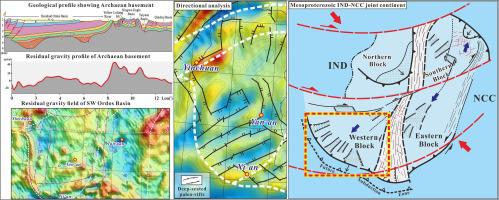当前位置:
X-MOL 学术
›
Precambrian. Res.
›
论文详情
Our official English website, www.x-mol.net, welcomes your
feedback! (Note: you will need to create a separate account there.)
Potential deep-buried petroleum systems in Meso-Neoproterozoic rifts of the southwestern North China Craton revealed by gravity anomalies
Precambrian Research ( IF 3.2 ) Pub Date : 2020-08-01 , DOI: 10.1016/j.precamres.2020.105764 Suhua Jiang , Gang Wang , Sanzhong Li , Guangzeng Wang , Xiyao Li , Huixuan Zhang , Wen Zhang , Wei Cao , Liming Dai , Yanhui Suo , I. Somerville
Precambrian Research ( IF 3.2 ) Pub Date : 2020-08-01 , DOI: 10.1016/j.precamres.2020.105764 Suhua Jiang , Gang Wang , Sanzhong Li , Guangzeng Wang , Xiyao Li , Huixuan Zhang , Wen Zhang , Wei Cao , Liming Dai , Yanhui Suo , I. Somerville

|
Abstract In order to evaluate the potential petroleum system within the Meso-Neoproterozoic strata of the southwest North China Craton (NCC), we explored the deep-buried basal tectonics on the Precambrian basement and the residual sedimentary thickness of the Meso-Neoproterozoic in the Ordos Basin. A combination of geophysical processing methodologies has been conducted. Based on regional seismic exploration, the shallow gravity effects caused by the undulation of the Cenozoic, Jurassic, Carboniferous and Cambrian sedimentary formations were calculated through forward modeling, and eliminated the free-air gravity anomaly by a gravity stripping technique. Subsequently, by using the wavelet multi-scale decomposition method, the deeper gravity effect sourcing from underneath the Meso-Neoproterozoic base was calculated and then eliminated, including the undulation of Paleoproterozoic-Archaean crystalline basement and the lateral density discontinuity of the lower crust. As a result, the residual gravity anomalies caused by the Meso-Neoproterozoic sedimentary formations and the Moho discontinuity of the Ordos Block were both obtained, which was then used for inversion. The inversion results show that the residual Meso-Neoproterozoic strata are mainly distributed in the southwest and northern part of the Ordos Block, and the Moho depth of the Ordos Block averages about 42 km. It ranges from 38 to 42 km in the eastern part and deepens to over 44 km in the west. In addition, there are some detailed deep-structure reflections on the Moho discontinuity. For instance, the parallel-arranged NE-trending anomalous belts in southwest Ordos Block indicate strong crustal extension and mantle uplift. The regional geology indicates that the NE-trending crustal extension is not related to the Cenozoic strike-slip pull-apart process around the Ordos Block, nor the Indosinian Movement in Early Mesozoic, or the cratonic depression in the Paleozoic. However, it highly resembles the NE-oriented paleo-rifts that developed in the Meso-Neoproterozic aulacogens. The residual crustal gravity anomaly eliminates both the shallow disturbance from the sediments and the deep shadow from the mantle. It shows very good consistency with the undulation of the Meso-Neoproterozoic sedimentary basement along a classical interpreted seismic survey line, which validates the correlation between the NE-trending anomalous belts with the basal aulacogen tectonics. According to seismic interpretation, the paleo-rifts within the Precambrian aulacogens occurred during the Mesoproterozoic and continued into the early Neoproterozoic. Huge volumes of sediment filled the rift troughs during the Meso-Neoproterozoic, causing a significant gravity loss on the gravity field, and formed considerable oil-gas exploration potential. Given suitable paleoclimatic conditions, the grabens would have provided a favorable environment for organic-rich shales and source rocks to develop. While the faults controlling the grabens and horsts would have played an important role in the migration and accumulation of hydrocarbons in the potential petroleum system. Combined with paleoclimate and lithofacies paleogeography analysis, five favorable areas are speculated for Meso-Neoproterozoic potential petroleum systems, which are the northwest Yimeng Uplift, the northern Tianhuan Depression, the southern Tianhuan Depression, the southwestern to central Yishaan Slope and the western Weibei Uplift, respectively. Based on lithofacies paleogeography, source rock maturity and organic carbon abundance, it suggests that the favorable petroleum systems within the Proterozoic strata of the Ordos Block were obviously controlled or influenced by the deep paleo-rifts and block faults, which resulted in forming three types of play, called the Weathering Model, the Tilting Model and the Transition Model. In particular, the central to western parts of the Yimeng Uplift and the southern Tianhuan Depression, where the Weathering Model developed, as the Upper Paleozoic coal-bearing source rocks have large hydrocarbon generation potential and good preservation conditions, these two areas should be regarded as important favorable prospecting regions in the Ordos Basin.
中文翻译:

重力异常揭示华北克拉通西南部中-新元古代裂陷潜在深埋油气系统
摘要 为评价西南华北克拉通(NCC)中-新元古代地层潜在油气系统,对鄂尔多斯地区前寒武纪基底深埋基底构造及中-新元古代残余沉积厚度进行了勘探。盆地。已经进行了地球物理处理方法的组合。在区域地震勘探的基础上,通过正演模拟计算了新生代、侏罗系、石炭系和寒武系沉积地层起伏引起的浅层重力效应,并通过重力剥离技术消除了自由空气重力异常。随后,利用小波多尺度分解方法,计算出源自中新元古代基底下方的深层重力效应,然后将其消除,包括古元古代-太古代结晶基底的起伏和下地壳的横向密度不连续性。从而获得了鄂尔多斯地块中-新元古代沉积地层和莫霍面断面引起的残余重力异常,并用于反演。反演结果表明,残留的中-新元古代地层主要分布在鄂尔多斯地块的西南和北部,鄂尔多斯地块莫霍面深度平均约42km。东部长38~42公里,西部深达44公里以上。此外,还有一些关于莫霍面不连续面的详细深部结构反射。例如,鄂尔多斯地块西南部平行排列的NE向异常带表明强烈的地壳伸展和地幔隆升。区域地质表明,地壳向NE向伸展与鄂尔多斯地块周围新生代走滑拉分过程、早中生代印支运动、古生代克拉通坳陷无关。然而,它非常类似于在中-新元古代发育的古裂谷中发育的 NE 取向的古裂谷。残余地壳重力异常消除了沉积物的浅层扰动和地幔的深影。它与沿经典解释地震测线的中新元古代沉积基底的起伏有很好的一致性,这验证了 NE 向异常带与基底造槽构造之间的相关性。根据地震解释,前寒武纪造陆裂谷内的古裂谷发生在中元古代,并持续到新元古代早期。中新元古代大量沉积物充填裂谷槽,重力场失重显着,形成了可观的油气勘探潜力。在适宜的古气候条件下,地堑将为富有机质页岩和烃源岩的发育提供有利环境。而控制地堑的断层对油气在潜在油气系统中的运移和聚集起到了重要作用。结合古气候和岩相古地理分析,推测中-新元古代潜在油气系统有5个有利区,分别为沂蒙隆起西北部、天环坳陷北部、天环坳陷南部、伊陕斜坡西南至中部和渭北隆起西部。结合岩相古地理、烃源岩成熟度和有机碳丰度,表明鄂尔多斯地块元古代地层内有利油气系统明显受深部古裂谷和块断层控制或影响,形成了三类玩,称为风化模型,倾斜模型和过渡模型。尤其是风化模型发育的沂蒙隆起中西部和天环坳陷南部,
更新日期:2020-08-01
中文翻译:

重力异常揭示华北克拉通西南部中-新元古代裂陷潜在深埋油气系统
摘要 为评价西南华北克拉通(NCC)中-新元古代地层潜在油气系统,对鄂尔多斯地区前寒武纪基底深埋基底构造及中-新元古代残余沉积厚度进行了勘探。盆地。已经进行了地球物理处理方法的组合。在区域地震勘探的基础上,通过正演模拟计算了新生代、侏罗系、石炭系和寒武系沉积地层起伏引起的浅层重力效应,并通过重力剥离技术消除了自由空气重力异常。随后,利用小波多尺度分解方法,计算出源自中新元古代基底下方的深层重力效应,然后将其消除,包括古元古代-太古代结晶基底的起伏和下地壳的横向密度不连续性。从而获得了鄂尔多斯地块中-新元古代沉积地层和莫霍面断面引起的残余重力异常,并用于反演。反演结果表明,残留的中-新元古代地层主要分布在鄂尔多斯地块的西南和北部,鄂尔多斯地块莫霍面深度平均约42km。东部长38~42公里,西部深达44公里以上。此外,还有一些关于莫霍面不连续面的详细深部结构反射。例如,鄂尔多斯地块西南部平行排列的NE向异常带表明强烈的地壳伸展和地幔隆升。区域地质表明,地壳向NE向伸展与鄂尔多斯地块周围新生代走滑拉分过程、早中生代印支运动、古生代克拉通坳陷无关。然而,它非常类似于在中-新元古代发育的古裂谷中发育的 NE 取向的古裂谷。残余地壳重力异常消除了沉积物的浅层扰动和地幔的深影。它与沿经典解释地震测线的中新元古代沉积基底的起伏有很好的一致性,这验证了 NE 向异常带与基底造槽构造之间的相关性。根据地震解释,前寒武纪造陆裂谷内的古裂谷发生在中元古代,并持续到新元古代早期。中新元古代大量沉积物充填裂谷槽,重力场失重显着,形成了可观的油气勘探潜力。在适宜的古气候条件下,地堑将为富有机质页岩和烃源岩的发育提供有利环境。而控制地堑的断层对油气在潜在油气系统中的运移和聚集起到了重要作用。结合古气候和岩相古地理分析,推测中-新元古代潜在油气系统有5个有利区,分别为沂蒙隆起西北部、天环坳陷北部、天环坳陷南部、伊陕斜坡西南至中部和渭北隆起西部。结合岩相古地理、烃源岩成熟度和有机碳丰度,表明鄂尔多斯地块元古代地层内有利油气系统明显受深部古裂谷和块断层控制或影响,形成了三类玩,称为风化模型,倾斜模型和过渡模型。尤其是风化模型发育的沂蒙隆起中西部和天环坳陷南部,











































 京公网安备 11010802027423号
京公网安备 11010802027423号